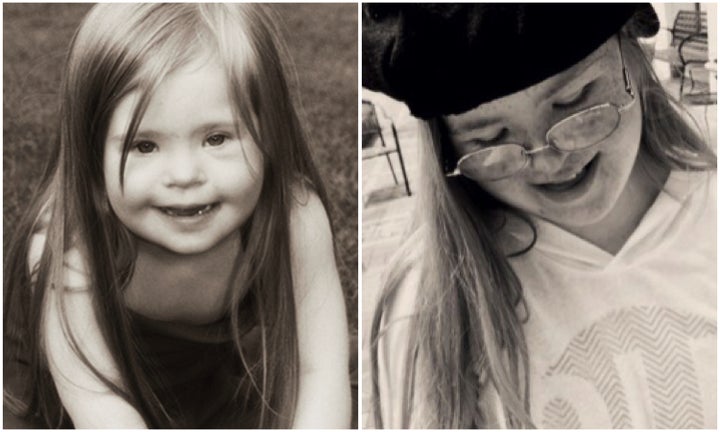
Congratulations!
Today is your day.
You’re off to Great Places!
You’re off and away!
Dr. Seuss
By the time Sydney was born I knew firsthand how quickly babies grow up. The journey away from their mothers and towards their own becoming begins with the first breath. I knew that my job as a mother was to guard my children’s safety while guiding them to autonomy; to teach them self-reliance and then . . . let them go.
I knew that never again could I protect them as much as when I carried them within my body, umbilical cord intact.
When Sydney was born, I knew my little one with Down syndrome would need extra protection. What I did not know was she would need independence and self-assurance just as much as the others. And she’d need me to teach her, then stand back and let her thrive.
I’ll never forget the first time I lost Sydney. One moment she was standing by my side, the next she was gone. Vanished. Nowhere to be seen. Panic doesn’t begin to describe the instant state of vertigo a mother feels on losing sight of her toddler; like I wouldn’t breathe again until I found her.
I’d read early on that wandering is a common behavior for children with Down syndrome, but like many new experiences, I didn’t get it until it started happening. I wouldn’t, however, call what Sydney did wandering.
- wan-der v. to go aimlessly, indirectly, or casually; meander.
There was nothing aimless or casual about her meanderings; they were purposeful and confident. More accurate terms to describe my daughter’s exploits would be elope and run away.
- e-lope v. to leave without permission or notification.
- run away v. to depart quickly; take to flight; flee or escape.
She was about 2 ½ when she mastered the art of a stealthy escape. Watching for an opening when my attention was diverted, she’d make her getaway, leaving me turning in circles, frantically uttering “Where’s Sydney?!”
Upon entering any new environment, my first priority was to secure the perimeter.
I lost her in the grocery store, in the mall among the clothes racks, in the endless aisles of Walmart. I lost her outdoors in crowds, at schools, at parks, at festivals and jam-packed events. I lost her at parties, in other people’s homes. I’d find her in the master bedroom digging through their drawers or in the laundry room, getting into a cupboard. She even climbed under the covers in bed once. With her shoes on.
I even lost her at home. One spring Saturday when Sydney was nearly 4 and I was pregnant with her sister, Haley, the whole family busied themselves with preparations to sell our house and move. My husband, Steven worked in the vast backyard, tending to an acre of walnut trees and gardens. I was shuffling things around inside, moving the boxes in various stages of packing that lined the walls. Open doors let the cool air circulate as our high-schoolers, Melissa and Jeremy, ran in and out.
Steven had Sydney with him out back, or so I thought. When he came in for a rest break ― alone ― I said, “Where’s Sydney?”
“I don’t know,” he shrugged. “I thought you had her.”
My stomach dropped. “I don’t have her. I thought YOU had her!”
I never got used to the gut punch accompanying the realization that she was gone, poof. Just like that.
A cursory search of the yard yielded no trace of her and with increasing urgency we spread the search in an ever-widening circle. I turned back to the house thinking maybe she’d snuck inside. I combed every room, closet, nook, under beds, calling her name, Sydney! SYDNEY!” louder and louder.
Twenty minutes ticked by, a veritable lifetime, and every minute I grew more panic-stricken. At that point, we called the local police and sent the kids and their friends out in all directions. By then, my perception of time warped and stalled. I willed it to stop until I could find my child, safe and sound. Only then could the world resume.
Images from every TV movie and national news story flooded my mind relentlessly with horrific possibilities causing my heart to race and my throat to lock down. Fear overwhelmed reason; hyperventilation threatened. I bent over to fight waves of nausea as Steven tried to calm me down with facts: it wasn’t likely she’d be kidnapped in our small town, traffic was light with the risk of her getting hit very low, and she couldn’t have gotten as far as the railroad tracks. Yet. But I could see as time pressed on, anxiety crowded the edges of his composure, too.
After thirty minutes of searching, I heard Melissa yell from the next-door neighbor’s house just 20 yards away, the words I’d been desperate to hear for a half hour.
“I found her!”
Relief flooded my system, and with it, more adrenaline dumped into my bloodstream. I thought I might vomit. Recovering quickly, I ran towards Melissa, calling as I went, “Where was she?”
“In Konya’s house.”
In our small town, people didn’t always lock their doors. Our little explorer had slipped away and crossed the small road dividing our house from the next, headed up the back stairs and let herself in to the neighbor’s. It appeared while our friends were away, Sydney helped herself to the toys on the sunporch, then continued inside where she’d played many times―when people were actually home.
While everyone was out looking, including the police chief himself, Sydney was at the neighbor’s, having a fine time alone, without a care in the world.
Her disappearing act continued, but once she discovered the enormous amount of attention her antics garnered, she started bolting. Instead of surreptitiously gliding away, she’d make a quick break. For a child who’s cognitively impaired, she was nothing short of cunning. She was smart, and she was fast. Despite having hypotonia (low muscle tone), she ran far enough and fast enough to evade capture unless a significant chase ensued. And so the game was on.
Laughing hysterically, hair flying in the wind, little legs pumping like pistons, completely oblivious to danger, she ran, looking over her shoulder to be sure we gave chase.
The more we followed, the faster she ran. The more she ran and we followed, the more the behavior was reinforced. Everyone knows the best way to extinguish undesirable behavior is to ignore it. But, we didn’t have a choice; we couldn’t not run after her.
And if I, her mother, couldn’t keep tabs on run-away bunny, how was I to send her out in the world? How was I to trust anyone else with her safety?
Sydney started school at only 3 years old. The early childhood special education program, held in a local church, featured a playground in the back parking lot—with no fence. We warned, “She’s a flight risk. You’ve got to watch her constantly.” Within the first week, I got a phone call from someone in town telling me Sydney had been found walking along a rural highway, picked up by a driver. The school didn’t even know she was missing.
She has eluded watchful eyes at every school since, taking side trips down hallways, foraying into other classrooms and even out into the woods during recess. She managed to get away from multiple babysitters, including the adult couple, a mom and dad, who watched all the kids during the rehearsal dinner for my sister’s wedding. Uneasy to leave her, we emphasized how closely she needed to be watched.
“She is an escape artist,” we said.
Sure enough, Sydney slipped out the side door of the guest house where we were staying, crossed the street, and proceeded through the grand entry into the hotel lobby. No one saw her get out. She wasn’t even missed until one of the other kids pointed out she was gone.
At home we installed locks, gates and alarms but she continued to foil her captors. Ultimately, we used a harness and a leash in exceptionally risky situations like airports. It was the only way I knew she was safe—if she was physically connected to me. The umbilical cord re-instated, my protective instincts were finally satisfied. As the terrifying challenge of holding onto her became our way of life, a pattern was formed: a habitual and unconscious sense of control I attempted to exert over the environment and my child’s relationship to it.
I became so accustomed to reining her in and holding her close because of my own fear that I forgot to notice when she no longer needed it.
No mother wants her children to suffer, and the desire to shield them from pain is as strong as her love for them is deep. But, I’ve had to ask myself when does sheltering children from life experiences no longer serve them in their journey to adulthood? When does buffering the natural consequences of my child’s choices become detrimental to the instinctual objective they were born to; that of growing away from me? Isn’t that the whole idea of having them in the first place?
Raising children means fostering the beautiful progression from the umbilical cord that sustains, to the leash that restrains, to the invisible tether that remains, connecting child to mother no matter the places they go.
Every day I take a deep breath. Every day I let go. Again. Then I send them out into the world, into their world. My children are able to venture out because they feel the safety in the tether that stretches as far as it must, without breaking. When my youngest, Haley, gets on the bus heading just one mile away to elementary school, she presses her face against the window and blows kisses at me. When Melissa gets in her car and drives hundreds of miles to her summer job in Colorado, she looks in her rear-view mirror and waves to me. And when Jeremy walks through security to catch a plane for Chile where he’ll spend the next two years, he turns and looks over his shoulder to see if I’m still there.
“Are you watching me, Mom?” they’re asking in that look. You bet I’m watching. And that’s all they need. Then they’re off and away.
Sydney’s a teenager now, outgrown the running-off phase. She frequently declines to hold my hand or even walk beside me in public. She doesn’t need my supervision at her cheer practices or my presence at her after-school clubs anymore. “I’m fine, Mom,” she says to me when I fuss. “I can do it.”
Yesterday I dropped her and a friend off at Kids in the Kitchen, a cooking summer camp for kids with disabilities. I’d barely parked the car before she unbuckled her seat belt, opened her door, and scrambled onto the sidewalk. With a quick, “Bye!” thrown over her shoulder, Sydney disappeared through the double glass doors with nary a glance back. I sat in the parking lot for a few minutes wondering if maybe I should just go in and make sure she got to the right place.
But I didn’t. She doesn’t need me to. Instead, I took a breath and let go. Again. “She’s fine,” I thought. “She can do it.”
You have brains in your head.
You have feet in your shoes.
You can steer yourself
Any direction you choose.
You’re on your own.
And you know what you know.
And YOU are the guy who’ll decide where to go.
Dr. Suess
